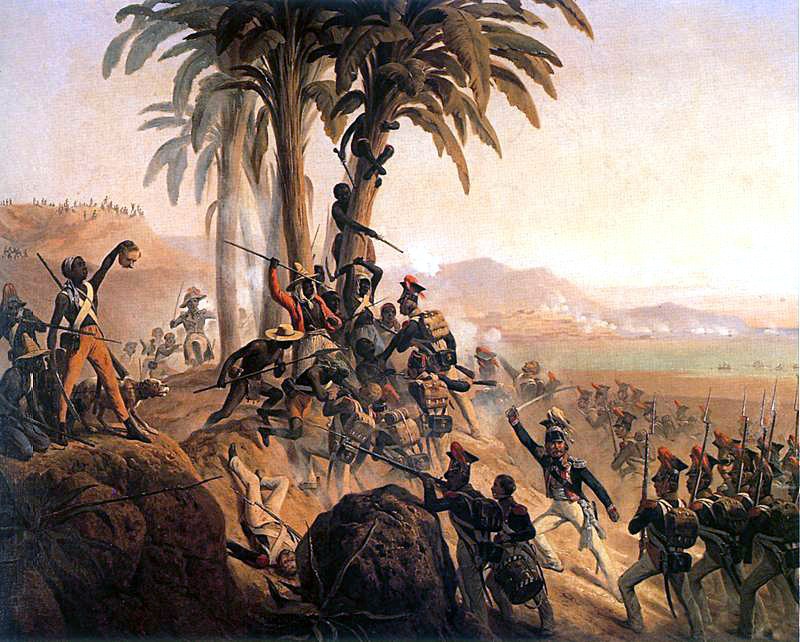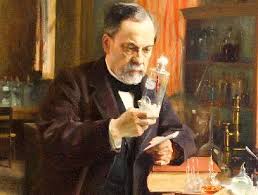The success of the American and the French Revolutions echoed through the people of the new and the old world. These events, powered by the Enlightenment ideas of popular sovereignty, individual freedom, and equality, proved that parting from powerful and oppressive rulers was possible.1 For the first time in recent history, the common man had united and fought for a republic based on the idea and practice of self-rule. This idea of fighting and revolting for independence traveled to slaves on the shores of a Caribbean island where the French had established the colony of Saint-Domingue in 1697.

Saint-Domingue was perhaps one of the most profitable lands that France had in its possession since it produced and exported coffee, indigo, tobacco, cotton, and sugar. The original aboriginal population of the islands had all but disappeared by the time the French had come to the island, and to make use of the colony, the French began to import slaves from Africa to work the fields. It is estimated that by 1789, the colony had a total of 500,000 African slaves, 35,000 white French settlers, and 50,000 colored freedmen who were French citizens and who also owned slaves.2 Despite slaves being the majority of the colony’s population, they lived under a strict and abusive social structure where they worked strenuous jobs under the threat of the whip, and would often starve to death. If runaway slaves were caught, they were often tortured and mutilated in order to dissuade other slaves that there was no escape from the chains of slavery. The daily life for the slaves of Saint-Domingue was one of fear and ill treatment.

French King Louis XIV established the “Code Noir” or Black Codes for the colony, which established rules for the treatment of slaves in all of its French American colonies. The code stated that slave owners were prohibited from sexually violating slaves or from torturing them, and they were required to provide food and clothes to the slaves. Nevertheless, slaves were regarded as property and could receive the death penalty if they did not comply with their masters.3
In 1788, fourteen slaves complained to the court that Nicolas Lejuene, a slave master’s son, would burn slaves alive, and although these acts were clearly violating the law, the courts and public opinion on the Island dismissed Lejuene and he was not prosecuted.4 This incident suggests that laws were not uniformly enforced in the colony, so masters had a free hand in their often atrocious treatments of their slaves. Many slaves ran away from their oppressive masters and hid in the mountains forming large communities of maroons. Their resentment to their French masters only escalated.5

With the ideas of political independence and social revolution circulating the world, slaves in the colony of Saint-Domingue were no longer willing to endure the treatment of their French masters. Tensions in the colony led to a violent uprising. The Haitian Revolution began in August 1791, when about 15,000 slaves destroyed and burned plantations and homes, and murdered white settlers in what was called the “Night of Fire.”6 This event encouraged the educated Catholic and former slave Toussaint L’Ouverture to join the cause. He helped train an army of 50,000 slaves in guerrilla warfare.7 The colony fell into chaos for years as the slaves revolted against French oppression in violent measures, and it was not long before the colony of Saint-Domingue was controlled by the slaves of the island.8

General L’Ouverture allied with the British in order to drive out the French settlers. But unwilling to let go of their colonial power, the French emancipated slaves in 1794; but they were still unable to secure and control the Haitian revolt. By 1803, L’Ouverture had proclaimed himself the governor of the colony, angering the powerful Napoleon Bonaparte who went after L’Ouverture, capturing and imprisoning him. This, however, did not weaken the resolve of the slaves to form an independent state. As Jean-Jacques Dessalines rose to power in the absence of Toussaint L’Ouverture, he ordered the gruesome execution of all Frenchmen in the colony. A year later, in 1804, Haiti was declared independent from French power.9
The slaves of Saint-Domingue were not expected to take on the example of the American colonies and the Enlightenment Era in order to fight for their independence. After the gory and terrible deaths of almost half the population in the colony–including French settlers, free black men and slaves–Haiti stood tall and free, shocking the world.10
- Jerry H. Bentley, Herbert F. Ziegler and Heather E. Streets-Salter, Traditions and Encounters: A Brief Global History Vol 2 (New York: MacGraw-Hill Education, 2016), 471. ↵
- Encyclopedia of Emancipation and Abolition in the Transatlantic World, 2007, s.v. “Haitian Revolution,” by Eugenio Matibag and Junius Rodriguez. ↵
- Philippe R. Girard, “Code Noir,” in Africa and the Americas: Culture, Politics, and History, no.1 (2008): 1. ↵
- Laurie M. Wood, “Across Oceans and Revolutions: Law and Slavery in French Saint-Domingue and Beyond,” Law & Social Inquiry 39, no. 3 (Summer 2014): 5. ↵
- Jerry H. Bentley, Herbert F. Ziegler and Heather E. Streets-Salter, Traditions and Encounters: A Brief Global History Vol 2 (New York: McGraw-Hill Education, 2016), 478-479. ↵
- The Black Past: Remembered and Reclaimed, 2007, s.v. “L’Ouverture Toussaint (1742-1803),” by Deborah McNally. ↵
- J. R. Beard, The Life of Toussaint L’Ouverture, the Negro Patriot of Hayti: Comprising an Account of the Struggle for Liberty in the Island, and a Sketch of Its History to the Present Period (Chapel Hill: University of North Carolina at Chapel Hill Library, 2012), 54. ↵
- Matt Clavin, “Race, Rebellion, and the Gothic: Inventing the Haitian Revolution,” Early American Studies, no. 1 (2007): 5. ↵
- Matt Clavin, “Race, Rebellion, and the Gothic: Inventing the Haitian Revolution.” Early American Studies, no. 1 (2007): 2. ↵
- Matt Clavin “Race, Rebellion, and the Gothic: Inventing the Haitian Revolution.” Early American Studies, no. 1 (2007): 5. ↵



70 comments
Yazmin Garza
I love reading about people of color rising up and overcoming their white captors. It warms my heart. It is so inspiring to read about the underdog winning the battle. The resilience displayed by the people of Haiti is something I hope history never forgets. I wish I had the opportunity to learn more about the origins of Haiti in a classroom setting because it sounds like the complete story is one worth knowing.
Sofia Resendiz
I visited the country of Haiti in July of 2017 and was able to visit their historical museum. This article was a refresher for as I read it, I was reminded of the history presented to us in the museum. It is amusing to know that slaves actually got the courage to stand up, and take control. My husband and had a conversation about how slaves in the United States could have revolted, and Haiti is such a perfect example.
Maggie Amador
Great article, It is devastating to see how horrible people were treated and how many lost their lives fighting for independence and freedom. It allows me to reflect on my own life and to appreciate the rights I have now. This article has also made me realize that I know nothing of the struggles a place like Haiti had to go through in order to become what we know to be Haiti today.
Valeria Perez
The French were very hypocritical when it came to the treatment of slaves. I was surprised when the article mentioned the Code Noir and how the French masters were not allowed to be cruel towards slaves. Still, they treated them as property and animals. It must have taken a lot of courage for the slaves to revolt and to continue fighting towards their goal when their main leader was captured. Great article!
Sienna Guerra
I really enjoyed reading this article because this slave revolt was the only successful slave revolt in Haiti. It is saddening to see that the slaved were treated the way they were under their masters. Even what is heartbreaking is that there were laws set in place to help the slaves but were never enforced. It is nice to see that thirteen years later, something finally happened for them and they held on until then.
Roman Olivera
Toussaint L’Ouverture was key in training the enslaved people of Haiti to fight a war that no one thought they could ever win. Angering the powerful Napoleon Bonaparte, seemed like a crazy thing for L’Ouverture to do and him being captured and imprisoned did not weaken the movement for freedom by the slaves. When Jean-Jacques Dessalines rose to power, and ordered the execution of all Frenchmen that was the final step to Haiti independence in 1804. The Haitian people seem to have had a lot fight in them and the men like L’Ouverture who are willing to risk everything for the human rights of all people are real heroes in the history of world.
Natalie Childs
This was a really great article. While I had known that the slave revolt in Haiti was only successful slave revolt, I had not known much more than that. It is heartbreaking the torment that the slaves endured under the masters and that the laws set in place to protect them were ignored by all. But it is also inspiring that they were able to hold and and continue on to have success, even though it took 13 years.
Natalia Flores
It always did make me wonder why slaves didn’t revolt since they usually outnumbered white populations, but this is horrendous. It’s very scary that the US didn’t really change after its “revolution” since it didn’t change the laws, but copied them. Hence, Jim crow laws and the Black Codes are eerily similar. Even though slaves couldn’t be abused, they still got abused (even burned alive) and its disgusting that the law turned a blind on to it.
Maria Esquivel
I knew the Saint-Domingue revolt was the only successful slave revolt but I never knew how it transpired so it was interesting to know how any why it occurred. I have read many stories on how slaves were treated but reading how they were mutilated for running away and burned alive was horrible. I am glad the slaves succeeded in fighting for their independence and no longer had to endure being tortured by the French.
Sam Vandenbrink
Interesting article. It’s always sad to hear about the tragedies that were caused by European exploitation on small countries. The Europeans Colonist have a bad habit of invading lands and enslaving the people. I’m glad the Haitian people were able to conjure up the courage to rebel against their masters. Continue the good work, this is a great article!